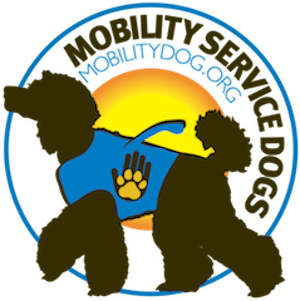A Love Story: The Co-Evolution of Dogs and Humans
Janie Heinrich, Founder of MobilityDog, Hugging Her Poodle Service Dog
We’ve been told that dogs are a human’s best friend; but in many ways, it’s an unlikely friendship. For example, ask yourself this, why we don’t have an even cozier relationship with chimpanzees and bonobos? After all, they are genetically far more similar to humans than canines.
Jane Goodall, the famous primatologist and foremost expert on chimpanzees, explains:
“Dogs … descended from wolves who were pack animals. They survive as a result of teamwork. They hunt together, den together, raise pups together … Chimpanzees are individualists … They are always on the lookout for opportunities to get the better of each other … If you watch wild chimps, you see the love between mother and offspring, and the bonds between siblings. Other relationships tend to be opportunistic.”
Chimps and dogs are both social, but their approach to living with their group members differs greatly, Goodall says. Our primate cousins lack what one author calls “kindness of heart,” which is essential to an enduring emotional bond among pack members. Anyone who has snuggled up with a pooch on a cold winter evening knows that dogs have an abundance of this trait.
We Humanize Our Pets
Black and Brown Puppies Cuddling on the Floor
In many ways, we consider our canine companions to be important members of our families. Obviously, we name them just like we do our offspring. As the popular film tells us, we also believe they all go to heaven. Many people refer to themselves as “dog parents,” and bumper stickers proclaim their dogs are their virtual children. We confer notional (if sometimes vague) rights upon our pets, and organizations like PETA are dedicated to enunciating and preserving those rights.
Fair enough, but why have these emotional bonds evolved and persisted across the 14 or so millennia since canine domestication began? We know that the presence of dogs benefits us, and vice versa, but how did our relationship evolve to the point of such deep bonds of affection?
Drugs May be the Answer
More precisely, a hormone called oxytocin. Oxytocin functions as a neurotransmitter in the brain. It’s thought to be a driving force behind attraction and caregiving, and even controls key aspects of the reproductive system, childbirth and lactation. Oxytocin has earned the nickname “the cuddle” or “love” hormone because it’s released when people snuggle up, have sex, or bond socially. Oxytocin also inhibits stress-related activity in the parts of the brain that respond to threats and promote fight-or-flight responses.
Social connection, and the behaviors and brain chemicals that facilitate it, played key roles in human evolution. One theory of human-dog co-evolution postulates that dogs evolved to use some of our human communications techniques (including the mutual gaze) to aid in connecting with their human benefactors. Oxytocin plays an important part in this method.
Dog-Human Gazing
In one experiment, a group of owners and their dogs spent time gazing into each other’s eyes, talking (human to dog) and touching. Their oxytocin levels were measured before and after these interactions. After gazing and touching, both humans and canines displayed elevated oxytocin. The same approaches were used with hand-raised wolves. But neither the wolves nor their owners showed higher oxytocin after their period of gazing. *
Young Black Poodle Gazing at Camera
In a second experiment, the researchers administered an oxytocin nasal spray to the dogs and observed their gazing behavior. They found that, after the oxytocin administration, female dogs (but not male dogs) significantly increased the duration of gazing at their owners. The experimenters hypothesized that female dogs are more sensitive to oxytocin, or perhaps that male dogs tend to be relatively more vigilant to strangers and less likely to feel a positive emotional attachment to unfamiliar people.
The researchers concluded that dogs evolved to use gaze (and the oxytocin release associated with it) as a means of social connection to strengthen their bonds with their owners. In essence, we and our dogs rely on an emotional loop: mutual gazing, mutual oxytocin release and mutual bonding. Wolves never developed this tendency. Indeed, with wolves in the wild, prolonged gazing is a form of threat, not a source of positive bonding.
It would appear that the process of co-evolution produced neural systems that facilitate gaze communications relying on oxytocin release. The researchers went so far as to call this process “a self-perpetuating oxytocin-mediated positive loop in human-dog relationships that is similar to that of human mother-infant relations.”
That puts a whole new light on dog parenting.
All Images Courtesy of MobilityDog.org.
Source:
Nagasawa, Miho et al, “Oxytocin-gaze positive loop and the coevolution of human-dog bonds,” Science, 17 April 2015, Vol. 348, Issue 6232, pp. 333 – 336.



